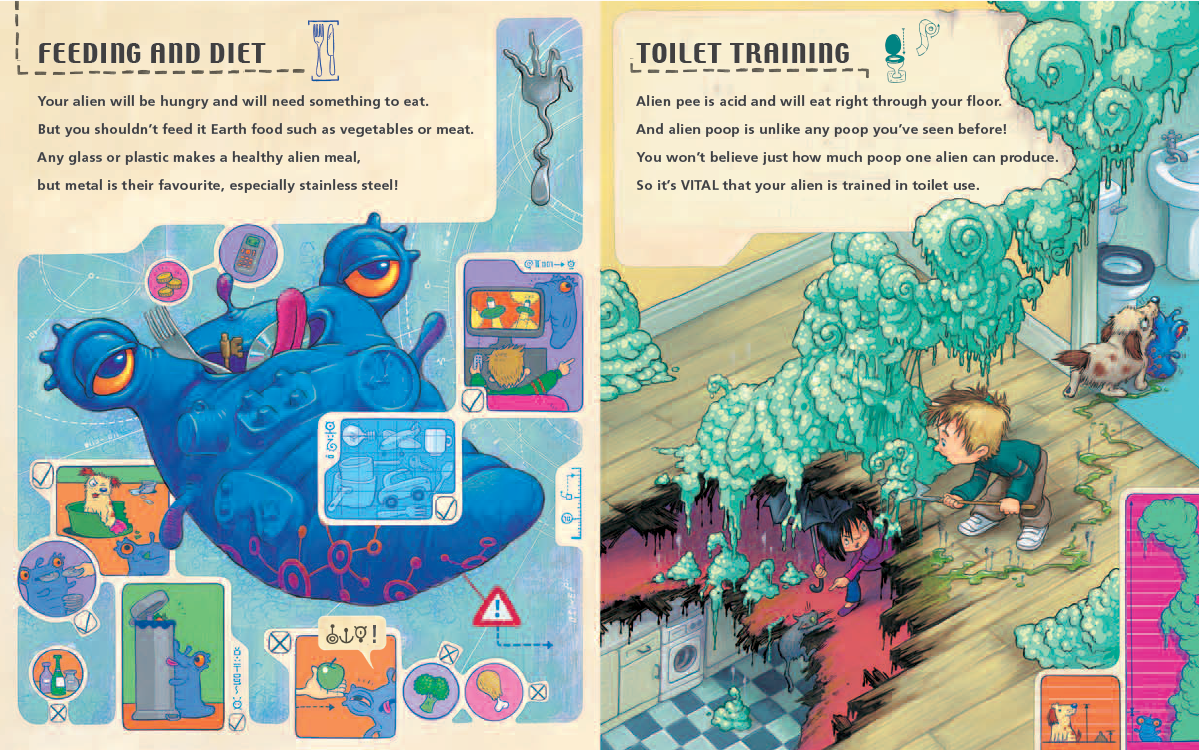
An Owner’s Guide
illustrated by Mark Oliver
MEET THE PET THAT’S OUT OF THIS WORLD!
Fed up with dull dogs and characterless cats?
Then try a pet alien!
This guide is packed with tips and advice on how to care for your very own extraterrestrial, from exploding egg to extraordinary adult.
Download the
ALIEN CODE CRACKER &
SPOT THE DIFFERENCE
activity sheets

After months of stopping and starting while writing MONSTERS: An Owners Guide, I’d anticipated that writing this second Owner’s Guide would be equally laborious, but it turned out to be much easier and it only took me a couple of weeks to complete the first draft.
While the monsters’ guide is written in the style of an instruction manual, the aliens’ guide is written in the style of a pet-care handbook. To get a feel for how these are organised and written I went to my local library and borrowed most of their collection of pet-care books. I made a wide selection, ranging from ordinary pets, like cats and dogs, to more exotic creatures, like spiders and snakes. When I took the books to the counter I was anticipating some comment from the librarian about my apparent indecisiveness or whether I was planning to open a small zoo, but she didn’t raise an eyebrow.
I also watched several of my favourite movies about aliens for inspiration. I thought it would be fun for the alien to have an insect-like life-cycle, starting with an egg, hatching into a larvae, then changing to a pupae before eventually becoming an adult. My inspiration for this was the Ridley Scott film Alien. However, the creature in that film is far too scary for a children’s book. I wanted my alien to be very friendly, intelligent and inventive and in this respect Steven Spielberg’s E.T. was also a big influence. There are quite a few other film influences in the book. The pet shop was partly inspired by the one at the beginning of Gremlins and readers might also spot references to Doctor Who, Men in Black, Star Wars and The Hitch-Hikers Guide to the Galaxy in Mark Oliver’s illustrations.
Mark did lots of different character sketches for the alien before arriving at the one that appears in the book.
One of the reasons this guide was easier to write than the previous one was that many of the real pet-care books I was using for reference were written for children so, although I still had to set my words in rhyme, I had less work to do in terms of adapting the style and content. Many of the phrases and section headings that I’ve use in the book are taken straight from real children’s pet-care guides. The title of the final section “Saying Goodbye” was the title of the final section in several of the books I looked at, although in those books the section was not about what to do when your pet decides to return to its home planet.
When I first showed the text to Mark, he suggested that the alien might cover the walls of the children’s home with strange symbols and diagrams and this gave me the idea to include the alien language in the book, which can be decoded using the decoder opposite the title page. As a boy, I had loved solving and creating codes and can still remember how much I’d enjoyed using a similar translator, printed on the back of a cereal packet to decode the messages on the Doctor Who monster cards included inside. The code messages in the book are all quite short, so if you fancy decoding some longer messages, you can find some on this activity sheet.
As usual, Mark has done a great job of illustrating the book, filling each page with amusing and inventive details. My favourite is probably the first spread where we get to see the inside of the slightly seedy alien pet shop, with its bizarre creatures and accessories.